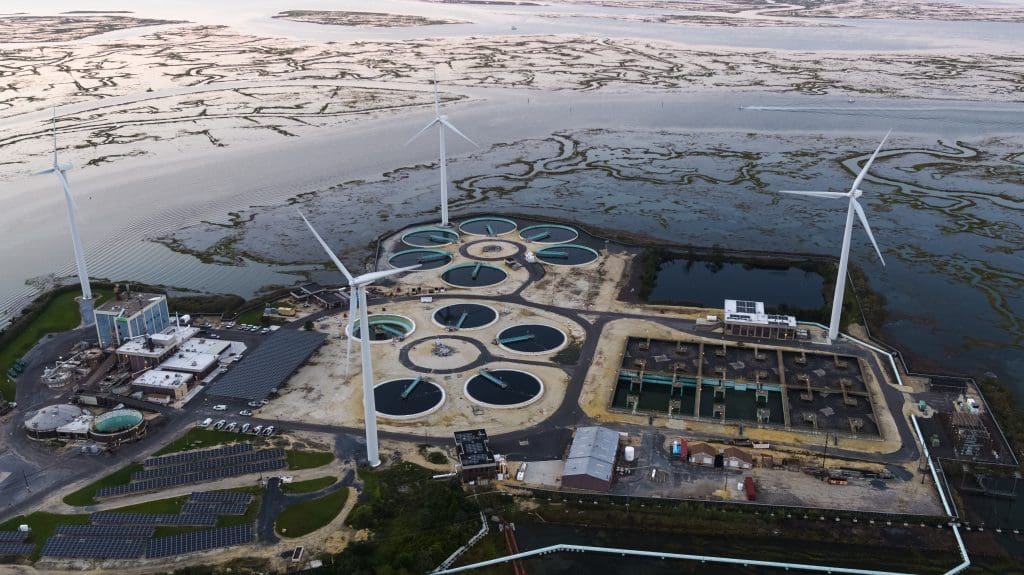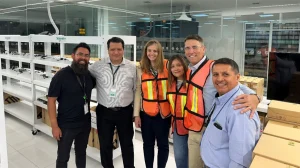We are watching the effects of climate change happen in real time now. Severe weather events are increasing in frequency and power, destroying infrastructure, erasing towns, and costing tens of billions of dollars. Such devastation sadly emphasizes the urgent need for climate risk mitigation and adaptation. Both approaches are especially relevant in the water sector. In this blog, we address the mitigation side of the story – and consider how it plays a crucial role in minimizing impacts by anticipating the risks of climate change.
The water industry’s role in carbon emissions
The water and wastewater sector is responsible for up to 10% of global emissions and 4% of total electricity consumption. Therefore, given its reliance on energy and energy-intensive operations and treatment processes, it is uniquely positioned to significantly mitigate the looming climate crisis. But, to achieve the global 1.5C temperature benchmark, the water sector must reduce its emissions by 50% by 2030.

The good news is decarbonization is entirely possible for the industry. With the right energy efficiency strategies, a 15-30% reduction in energy consumption is achievable. This can lead to thousands of dollars in cost savings and faster payback periods—benefits that can drive sustainability and financial performance. Combining energy efficiency measures with on-site or self-produced energy from wind, solar, biogas, or hydropower is now on the agenda for many water utilities as they work toward energy neutrality over the next two decades. Optimizing energy efficiency will also help this sector reach its Scope 1 and 2 decarbonization goals. These efforts are vital to the global transition to net zero. To achieve this, digital transformation is key.
Let’s explore how digital innovations such as advanced energy management tools, artificial intelligence, and IoT-connected technologies can drive sustainability within the water sector.
Gassing up the climate
Much of the water sector’s carbon footprint is due to energy consumption and direct emissions from treatment processes. Global estimates place the industry’s energy draw at about 1,000 TWh of electricity annually. That’s almost double France’s annual electricity consumption. In addition, that energy use is a big contributor to the production of global emissions of 850 million CO2e – equivalent to that of the entire airline industry. These global figures include water cycle infrastructure and on-site sanitation. The latter is responsible for about 30% of emissions, and those are primarily Scope 1 emissions from septic tanks and latrines.
Within the water cycle infrastructure alone, about 75% of the emissions come from the energy required to pump, treat, and transport water. The remaining 25% are direct emissions, mainly produced at wastewater treatment plants. These emissions are primarily Methane (CH4) and Nitrous oxide (N2O).
Both gases have significantly higher warming potentials than CO2. Methane alone accounts for one-third of global warming, with 27 times the warming potential. Nitrous oxide is 300 times more powerful and stays in the atmosphere for up to 150 years.
Close to 60-70% of a wastewater treatment plant’s carbon footprint comes from direct emissions. Therefore, tackling these emissions is crucial for meeting global decarbonization targets. By improving energy efficiency in water management and reducing direct emissions, the water sector can be pivotal in reducing its environmental impact. However, utilities will require innovative solutions to reduce these harmful gases effectively.
Direct emissions: Making the invisible visible
Nitrous oxide (N₂O) production in wastewater treatment plants is closely tied to how biological treatment processes are managed. This requires careful balancing with the energy used for aeration. However, precise data within the water industry is lacking. This underscores the need to move beyond rough estimations to innovative solutions like real-time monitoring and accurate assessment of these greenhouse gases. This approach is crucial to effectively tackling emissions reduction.
Digital transformation offers a lifeline, starting with IoT connectivity powered by AI and digital twins. AI-driven solutions provide predictive insights that allow utilities to optimize operations, reduce waste, and cut emissions. Digital twins—virtual replicas of physical systems—enable operators to test and refine processes in a risk-free, simulated environment.
By leveraging these insights, the water industry can make informed decisions that enhance efficiency and sustainability. Building on this foundation, the game-changing technology of Schneider Electric and its partner Variolytics combines advanced real-time monitoring of GHGs with cloud-based architectures and AI-driven process-control applications for aeration. This cutting-edge solution allows water utilities to monitor emissions in real time and make informed decisions about optimizing their carbon footprint.
For example, at Canal de Isabel II in Madrid, Schneider Electric’s collaboration with Variolytics uses real-time emissions monitoring to detect peaks in greenhouse gas emissions and pinpoint opportunities for operational improvements. This level of precision helps water utilities make informed carbon footprint mitigation decisions while maintaining operational efficiency. The solution has already demonstrated its ability to swiftly detect peak contamination events in real time and pinpoint opportunities for operational enhancements.
Microgrids: Powering the future of water utilities
One of the most exciting advancements in digital transformation is the rise of microgrids. These intelligent energy systems allow water utilities to manage the energy mix in a flexible way, including from diverse renewable energy sources like solar and biogas —while ensuring consistent power to their operations. Microgrids can balance energy production and consumption in real-time, reducing the reliance on fossil fuels and minimizing Scope 2 emissions.
The microgrid solution at EMACSA (Empresa Municipal de Aguas de Córdoba S.A.) is a great example. This flexible, certified system helps manage renewable energy sources at the wastewater treatment plant while ensuring compliance with regulatory standards. Microgrids make energy more sustainable and improve resilience against power disruptions, a crucial feature in the face of extreme weather events.
Decarbonization: Improving energy efficiency in water management
As more utilities aim for energy neutrality and net-zero goals, the water sector’s decarbonization journey is gaining momentum. Energy efficiency measures alone can reduce energy consumption by 15-30%, while onsite renewable generation, such as biogas from sludge, can potentially cover 50% of some utilities’ energy needs.
These technologies, from AI-driven optimization to intelligent microgrids, support decarbonization and empower water utilities to thrive in a rapidly changing environment.
The future starts now: Embrace digital transformation in water management
The challenges facing the water and wastewater industry are vast, but the opportunities for innovation are even more significant. Digital transformation, powered by advanced tools like AI, digital twins, and microgrids, is the key to reducing emissions, optimizing resources, and ensuring long-term sustainability.
Ready to lead the decarbonization movement? Now is the time to embrace these digital innovations. Click here to find out more.




Add a comment